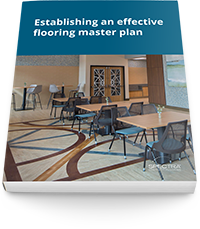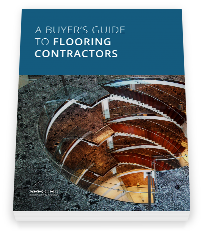Office flooring: A room-by-room guide to selecting flooring materials
When selecting office flooring materials, both form and function should be top-of-mind considerations. And because each room has a different function, one flooring material likely won’t work for your whole office—what works in a lobby won’t necessarily work in your office kitchen.
The best way to select office flooring materials is to go room by room and choose materials that match the function of each space, align with your design preferences and fit your cost constraints.
Four rooms to consider when selecting office flooring materials
-
Lobby and reception areas
Durability and design are key considerations when selecting a flooring material for your office’s lobby. The lobby is the first thing customers, stakeholders, vendors and new employees will see. Your reception area flooring, therefore, must make a good first impression. It must also be able to withstand a high level of foot traffic without showing it.Here are a few materials that are durable and aesthetically pleasing enough to be used in your lobby:
- Terrazzo
- Wood finishes
- Luxury vinyl tile (LVT)
-
Open office spaces and break rooms
Office area flooring must match your facility’s desired aesthetic, absorb excess background noise and withstand high levels of foot traffic. It needs to tie into the design of your facility, and its maintenance costs need to fit into your budget. Durable, easy-to-maintain materials are best in general office areas.Here are a couple materials that would work in general office areas:
- Carpet
- LVT
-
Conference rooms
Conference rooms are the backdrop for important meetings with potential employees, clients and stakeholders. Because of this, design cannot be ignored in conference rooms—your flooring selection must make a good impression and fit with the room’s overall design aesthetic. While durability should always be a consideration when selecting flooring, it is less important for conference rooms because they generally have less foot traffic than the common areas of your office. Design should be your key concern.Here are a couple materials that would work in general office areas:
- Wood finishes
- Luxury carpet
- LVT
-
Kitchen areas
Slip-, spill- and water-resistance should be top-of-mind when selecting flooring for your office kitchen. Kitchen flooring must also be easy to clean, maintain and repair, as spills are common and cleanliness is a must in food preparation areas.Here are a couple materials that would work in your kitchen area:
- Quarry tile
- LVT
- Linoleum
The recommendations above are only a few of the best-fit options for each room—your material options are virtually limitless. With your design and budget in mind, your flooring contractor should be able to guide you toward the best flooring material for each distinct area of your office.

Establishing an effective flooring master plan
Is your flooring lasting its full lifespan? These industry-proven strategies help facility managers keep flooring systems clean, safe and reliable for years to come.
The five best office flooring options
Now that you know which flooring materials might work for each area of your office, you should take a closer look at which materials fit your design preferences and cost constraints.
-
Terrazzo
Terrazzo is a LEED-friendly seamless flooring system known for its durability and design versatility. It offers virtually limitless design and color options, perfect for companies that want to greet visitors with a custom logo or unique pattern reminiscent of high-end marble tile. Because terrazzo is easy to clean and maintain, it also offers great lifetime value. If installed and maintained properly, terrazzo can last for decades to come.
-
Wood finishes
Commercial wood flooring such as solid hardwood, engineered hardwood and locking hardwood floors offer an elegant look perfect for impressing visitors in lobby and conference room spaces. Although real hardwood isn’t as cost-effective as its synthetic counterparts, it offers a classic look perfect for some design schemes. Engineered hardwood is an environmentally friendly alternative to real hardwood flooring, and offers virtually the same durability and design benefits.
-
Luxury vinyl tile (LVT)
Vinyl tile, and particularly luxury vinyl tile (LVT) is a great fit for office applications. LVT is incredibly durable, easy to maintain and versatile. With a wide variety of finishes and design options, it integrates seamlessly into almost any design scheme, making it a perfect fit for practically every room in your office.
-
Carpet
Both broadloom carpet and carpet tiles are great options where sound absorption and durability are concerns, such as in open-office areas and common rooms. Carpet is aesthetically pleasing, environmentally friendly and durable. Broadloom carpet is cheaper up front, but not as easy to maintain as carpet tile. To learn which option is right for you, check out our guide to commercial carpets.
-
Quarry tile
Quarry tile is the industry standard for commercial kitchen spaces, and has been for decades. It provides excellent lifetime value—quarry tile is cheap to install and durable by nature. Quarry tile is easy to clean and maintain, and able to withstand spills and heavy foot traffic common to kitchen areas.
You should choose office flooring materials by room, function, design preferences and, of course, cost. A flooring contractor should be able to guide you toward materials that not only fit those requirements, but provide the best lifetime value when you weigh installation and maintenance costs. To learn how to reduce costs, realize value and identify quality contractors, read our buyer’s guide to flooring contractors today.

A buyer’s guide to commercial flooring
How to get the greatest-value floor and select the right contractor for your project.

